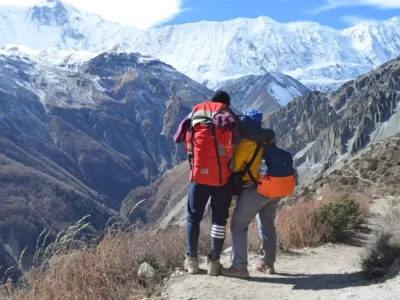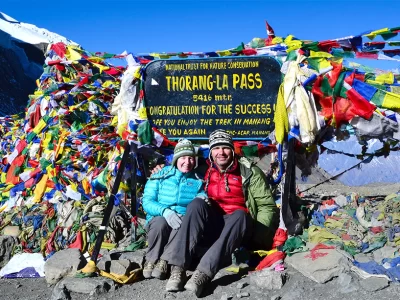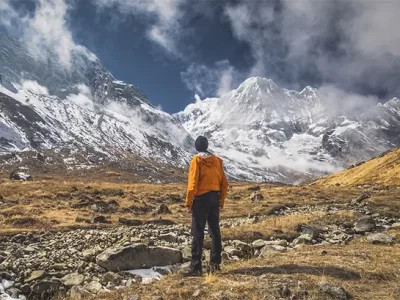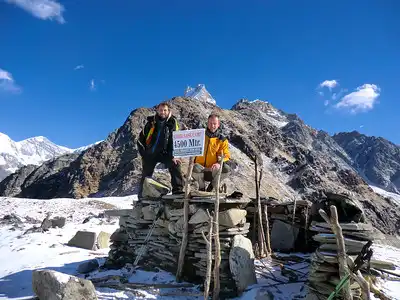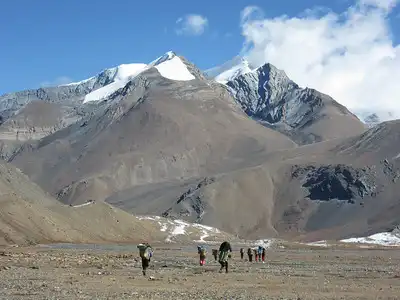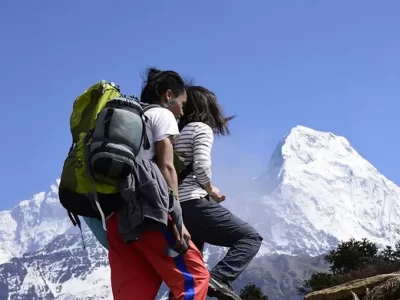You can prepare yourself for this trip by coming up with a detailed Annapurna Circuit Packing List. The appropriate gear is fundamental as it will not only enhance your safety but also comfort you throughout contrasting climates and terrains of the trek; thus, you need it to stay and enjoy yourself. The Annapurna Circuit trek is one of the most widely renowned and diverse treks one can undertake in the world today.

Lush subtropical forests, arid cliffs, and high mountain passes such as the formidable Thorong La Pass define the Annapurna Circuit, presenting a unique challenge to trekkers. Locally known as the Annapurna Trek, this route offers a wide variety of experiences, from viewing ancient temples and monasteries to encountering diverse wildlife. Packing appropriately for such a varied adventure proves essential, as weather conditions can shift rapidly and physical demands intensify with elevation.
Annapurna Circuit Trek
Mini Annapurna Circuit Trek
Annapurna Base Camp Trek
Essential Gear
Headwear
- Brimmed Hat or Sun Cap
- Sunglasses
- Buff/Neck Warmer/Neck Gaiter
- Knit Hat (preferably made of fleece or wool)
- Balaclava
- Bandana or Headscarf
- Torso Clothing
Lightweight Thermal Tops
- Polypropylene Shirts (long or short sleeves) suitable for trekking at lower altitudes
- Fleece Pullover or Jacket
- Waterproof Jacket
- Sports Bra (for women)
- Down Jacket (Puffer Jacket)
- Insulated Jacket (either synthetic or down)
- Soft Jacket (made of fleece or soft shell material)
Lower Body Clothing
- Hiking Pants
- Fleece Pants
- Light Thermal Trousers
- Underwear
- Hiking Shorts (optional for summertime trekking)
Footwear
- Trekking Boots
- Hiking Socks
- Trekking Sandals
- Cotton Socks (optional)
- Gaiters (optional)
- Running Shoes or Trainers (optional)
Technical Gear and Equipment
Backpacks
A comfortable and functional backpack, essential for carrying all your trek essentials, should have a capacity of 50-65 liters.

It needs adjustable straps for a secure fit, multiple compartments for organization, and built-in rain covers for wet weather protection.
Sleeping Bags and Pads
Choose a sleeping bag that’ll keep you warm at -10 degrees for the high places of Annapurna Circuit, where there is a wide temperature range. Also, you will need a sleeping mat for both comfort and to protect your body from the cold union of the earth. The R-value is higher in the more insulated pads, and so should be selected.
Trekking Poles
Trekking poles reduce knee impact and improve balance on uneven trails. Opt for poles that are lightweight, adjustable, and equipped with comfortable grips. Poles with shock-absorbing features and durable tips will serve well across the varied terrain of the Annapurna Circuit.
Mardi Himal Trek
Dhaulagiri Trek
Ghorepani Poon Hill Trek
Navigation and Communication Tools
Maps, Compass, and GPS Devices

Indispensable on the Annapurna Circuit, navigational tools like maps visually lay out the trekking route and aid in planning daily itineraries. A compass, when paired with a map, helps you maintain your course in poor visibility or remote areas. GPS devices provide real-time location tracking, enhancing safety and allowing trekkers to navigate confidently through the circuit’s diverse terrains.
Satellite Phones and Emergency Communication Devices
The remote nature of the Annapurna Circuit necessitates reliable communication tools. Satellite phones provide connectivity well beyond the range of regular mobile networks, which is crucial for emergencies or important updates.
While camping or hiking in remote areas, always bring along emergency communications equipment such as personal locator beacons (PLBs) or satellite messengers that enable you to activate a distress signal in case an emergency occurs, and rescue teams can locate you more easily.
Annapurna Circuit Packing List: Health and Hygiene
First-Aid Kit: Essential Items and Medications
A comprehensive first-aid kit effectively addresses minor injuries or health issues on the trek. It should include bandages, antiseptic wipes, blister treatments, and various gauze and tape. Essential medications like pain relievers, anti-inflammatory drugs, and altitude sickness pills, such as Acetazolamide, must also be packed along with any personal medications.
Water Treatment Solutions
Ensuring that the Annapurna Circuit has access to clean drinking water is crucial. To overcome challenges in accessing clean water, include effective water treatment solutions such as iodine tablets, chlorine drops, or a portable water filter. These treatments help you hydrate safely without the risk of contracting waterborne diseases.
Personal Hygiene Products and Toiletries
Personal hygiene remains crucial for comfort throughout the trek. Your pack should include biodegradable soap, toothpaste, a toothbrush, and toilet paper. Appropriate sanitary products for women are essential. Include wet wipes and hand sanitizer to maintain cleanliness when water is scarce.
Nutrition and Food Supplies
Recommendations for High-Energy Foods and Snacks
High-energy foods and snacks play a vital role in sustaining energy throughout the Annapurna Circuit. Pack items like nuts, dried fruits, granola bars, and energy gels, which offer quick calories and are easy to consume on the go. Also include high-calorie, nutrient-dense foods such as peanut butter, oatmeal, and trail mix, ideal for the demands of longer treks.
Meal Planning for Longer Trek Segments
Prioritize variety and nutritional balance when planning meals for extended trek segments. Incorporate carbohydrates for immediate energy, proteins for muscle repair, and fats for sustained energy. Lightweight, pre-packaged dehydrated meals only require hot water for preparation, making them a convenient choice after long trekking days.
Cooking Gear If Self-Catering
Please be sure to carry the appropriate cooking gear if you want to self-cater. Essential items include a lightweight, portable stove, fuel canisters, a small pot, and possibly a lightweight pan. Remember to pack utensils such as a spoon, knife, and a durable, lightweight plate or bowl. A compact cleaning kit will help keep your cooking equipment sanitary.
Miscellaneous Items
Sun Protection: Sunglasses, Hat, and Sunscreen
Sun protection is crucial on the Annapurna Circuit. Equip yourself with UV-protection sunglasses to shield your eyes, a broad-brimmed hat to protect your face and neck, and regularly apply high SPF sunscreen to exposed skin to prevent sunburn.
Cameras and Extra Batteries
A durable, high-quality camera is essential for capturing stunning landscapes and preserving memories of your trek. Choose a camera considering weight and durability. Ensure you pack extra batteries and memory cards, as cold temperatures can quickly drain battery life, and you may encounter limited charging options on the trail.
Important Documents: Permits, Identification, and Insurance Information
Carry all necessary documents for the trek, including trekking permits, personal identification, and travel insurance documents that provide coverage for high-altitude trekking. Store these documents in a waterproof pouch to protect them from damage during the trek.
Tips for Packing Efficiently
How to Pack Your Backpack for Balance and Accessibility Properly packing your backpack is crucial for comfort and efficiency during the trek. Achieve optimal balance and accessibility by following these steps:
Bottom Layer: Place lighter, bulkier items like sleeping bags and pads at the bottom of your backpack. This arrangement lowers the center of gravity, enhancing stability.
Middle Layer: Pack heavier items close to your back and center them between your shoulder blades. Storing your food stash, cooking gear, and water reservoirs here keeps the weight central and close, improving balance and reducing strain.
Top Layer: Keep frequently used items and essentials such as your first aid kit, rain gear, snacks, and navigation tools in the top layer and outer pockets. It ensures that these items are easily accessible without requiring you to unpack other gear.
External Attachments: Attach items like trekking poles and water bottles to the backpack’s external loops and straps. It makes these items quickly accessible and helps manage items that cannot fit inside.
Tips on Reducing Weight Without Compromising Essentials
Reducing the weight of your backpack is essential for a comfortable trekking experience. Here are strategies to lighten your load without sacrificing necessary items:
Multi-use Items: Choose gear that serves multiple purposes. For instance, could you use a bandana as a neck gaiter, towel, or pot holder? This strategy reduces the total number of items you need to pack.
Optimize Food and Water: Opt for dehydrated meals and high-calorie snacks to decrease weight. Carry only as much water as you need until your next refill point, planning around safe water sources along the route.
Review and Rationalize: Spread out all your gear before packing and critically assess each item. Eliminate any items that are not essential or unlikely to be used.
Lightweight Gear: Select lightweight and compact versions of essential gear such as tents, sleeping bags, and cooking systems. These choices can significantly lighten your base weight.
Pack Smart: Utilize compression sacks to minimize the volume of soft items like clothing and sleeping bags. This technique not only simplifies packing but also creates space for other essentials.
Conclusion
Efficient packing for the Annapurna Circuit proves vital for a successful and enjoyable trekking experience. Keep balance and accessibility in mind while packing your backpack, ensuring effortless access to essential items while maintaining trail stability. Moreover, prioritize reducing weight without compromising necessary gear by opting for multi-use items, optimizing food and water choices, and selecting lightweight gear.
Customizing your packing list based on personal needs and trekking style is crucial, as preferences and requirements vary among individuals. Please feel free to adapt the suggestions you provided to suit your unique situation. Lastly, please share your packing tips and experiences in the comments below, offering valuable insights to fellow trekkers gearing up for their Annapurna Circuit adventure!

